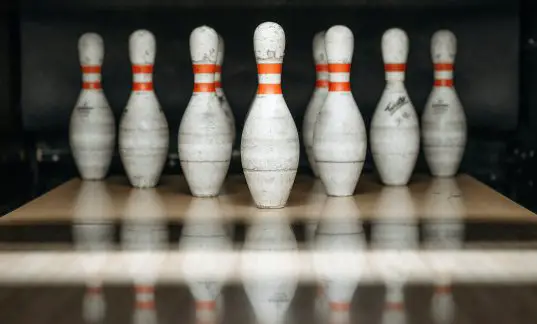Whether you’re a right-handed bowler or a left-handed bowler, the importance of proper body position and a strong shot approach cannot be overstated. Bowling isn’t just about releasing the ball and hoping for good things to happen. Most bowlers of the casual persuasion swing freely and wildly, limiting their effectiveness and lowering their bowling scores across the board.
This may work for many bowlers looking to have a good time on a Friday night, but it’s not going to work for a serious bowler. If you’re really trying to get better at the game, everything from your bowling hand to your body weight distribution needs to be on point.
To help you put together a solid approach of your own, we’ve created this extensive guide for fine-tuning your bowling shot. We’ll answer a few key questions you may have in the process, including the biggest one — how many steps should you take before you reach your finish position?
(Four, it’s four.)
(Unless it’s not.)
Analyzing a proper four-step delivery in bowling
The first thing you need to do to put together your best bowling shot is to put everything together into a simple four-step approach. Right-handed bowlers and lefties alike should be mindful of their step counts, and the progress of their throwing motion as they go along.
If you want to slot the ball into the pocket time after time and stop hammering the head pin straight on (or missing it altogether), take notes. The following 4-step delivery method will help you drop more pins and feel comfortable while doing so.
1) Right Foot For Righties, Left Foot For Lefties
Your first step should be coordinated with the throwing arm you use. If you use your right arm, your right leg should be the first to move forward. If you use your left arm, your first step should come with your left foot.
The first step of your approach should be shorter than the extension of your arm on the push away. Your bowling stance should be relaxed enough to be comfy, but rigid enough to provide power and momentum. Your body’s weight should be above your feet, while the ball must be extended beyond your first step. For optimum balance and throw power, step heel to toe with a short explosive opening burst.
2) Beginning The Down Swing With Your Bowling Ball
Your second step will come with the opposite foot and should be longer and stronger than the first. While the ball drops from the opening push, your other arm should come up at the same time to mimic an airplane wing of sorts. By doing so, you can calibrate your downswing and keep your momentum in a straight line towards the center dot (and the pins.)
As your opposite arm lifts up, your throwing arm should be at the lowest point of your swing just clearing your ball-side knee. You’re basically at the middle point of your approach, with your lower body doing the work to load up for your throw.
3) Completing Your Backswing On The Third Step
You’ll step back onto your dominant foot with your third stride, completing what is known as the “power step.” Your bowling ball will reach the highest point of your swing on this step, gathering momentum for tons of violent fun down the lane.
The third step is a matter of conjecture for serious bowlers. Traditionally, bowling coaches have advocated for longer and longer steps with each stride. However, some critics believe that a more measured and confident step is more appropriate here. It wouldn’t hurt to test both out and see what you’re most comfortable with.
Whether you choose a longer third step or a fiery slide step, be sure to have your dominant knee bent slightly by this point. You can drop even lower by bending further if you’d like, adding more power and a bit more oomph to a potential curve. As your bowl towards your target, this drop will aid in making pins fly and hooks snap with efficacy.
4) Pass The Ankle Of Your Slide Foot With Your Shot
When you execute your fourth and final step, it becomes a slide-and-release proposition. As your bowling ball moves forward on the fourth step, your ball-side leg should be behind you while your foot rolls onto its instep. You should then execute your release as soon as the ball passes the ankle of your opposite sliding foot. If you’re throwing from the right side, the ball will pass your left ankle. It will be vice versa for lefties.
Don’t stress if this doesn’t make sense right off the bat. Perfecting your bowling shot and four-step delivery takes time and effort. It also takes a bit of perspective.
And here’s the catch — if a normal four-step approach doesn’t work for you, you can shorten it or lengthen it based on need!
What is the 3-step approach in bowling?
A 3-step approach starts closer to the foul line and ends with you stepping on your dominant foot. For bowlers who want a little more control and finite movement with their approach, a three-step approach is more compact and shortens your delivery time considerably. We recommend only using a three-step approach if you’re a finesse bowler who knows what they’re doing. Finishing your shot on your dominant foot is tricky to pull off, especially when throwing on the third step.
If you can pull off a three-step approach, though, you might be in business for increased spares and better straight-line strike power.
What is the 5-step approach in bowling?
A 5-step approach gives you the added benefit of more momentum and potential boosts in overall shot power. Again, this shot approach ends with you standing on your dominant foot so you have to be precise with your footwork and smart with your mechanics. If you’re looking to add velocity and potential creativity on the back end with your hooks, a five-step approach might be the way to go.
The problem with a five-step approach, though, is that there’s more of a chance that you’ll make a mechanical mistake. The more time you spend between the start of your approach and the beginning of your shot, the more opportunities there are for your form to go out of whack and your shot to go with it. Use a 5-step approach only if you’ve studied enough to make it work.
What approach should you use when bowling?
Most bowlers should stick with a four-step approach. It’s a tried-and-true method for shooting a bowling ball and gives beginners and intermediate bowlers the best chance to succeed. Advanced bowlers should perfect a four-step approach first before moving to a three-step or five-step approach. Getting the basics down is essential to becoming the best bowler you can be.
Other key approach tips of the most successful bowlers
When executing your approach and working on proper body position during a throw, keep these additional bits of advice in mind —
- Always follow through on your shot with your throwing elbow rising above your shoulder. If your slide foot knocks you off-kilter or your fall away from your shot in an unbalanced position, you will lose power and accuracy. The follow-through is a critical part of any shot and approach and needs to be taken just as seriously as your footwork.
- Your optimal distance from the foul line when starting your approach will vary. A general rule of thumb is to start your approach with you feet about four-and-a-half steps away from the foul line. If you feel rushed at the end of your throw or like you need to take a fifth step to complete your motion, adjust your placement and go from there.
- Don’t get locked into the middle of the lane. This is especially true if you’re playing around with hook shots. The center of the lane is a good place to start and line up with your target, but moving a few boards left or right could be the difference between splits and strikes.
- Monitor how the ball reacts after your release. Take notes on the different results of different swings. If you’re tired, monitor how your balance and ball action is affected. If you’re throwing a bit softer, keep tabs on how the ball spins and reacts down the lane. The more studied you are about your approach and bowling shot, the better results you’ll see as time goes along.
How do I fix my bowling approach?
Keep these common bowling shot foibles in mind when putting your approach together. They could spell trouble for your throw and lead to lower score (and even, potential injury.)
- Don’t forget to cross over your first step. For right-handers, this means cross your left leg behind your right at the beginning of your approach. If you don’t, you might veer off of your straight line or even hit yourself with the bowling ball.
- An inconsistent swing is a shot killer. If your shot lacks calibration and balance at any point of your approach, your throw could be completely sabotaged. Also, bad approach and swing mechanics are the number one cause of injury at the bowling alley. Be mindful of your posturre and keep your arm in line every time.
- Don’t overthrow. And don’t use a heavier ball just to show off. You don’t need to prove your strength at the risk of your health. And, sometimes throwing hard has the opposite effect to a finessed, well-rounded approach. Be mindful of your body and your limitations. Your bowling scorecard (and your health insurance budget) will thank you.

